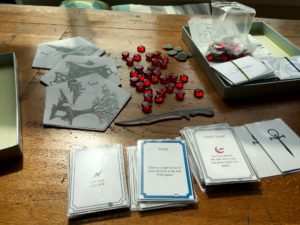Finding the fun in game design
(Posted in 2016, but I think it still has value)
Designing a game often feels like finding your game.
First you have an idea, then you create a prototype (a “hypothesis”) and then you play it. Then you evaluate it to see what attributes you liked and what you didn’t, and try to surmise why.
You also notice subtle emotional and unexpected results, like a smile on someone’s face when they played a card, or how they pantomimed with a prop, or why they screamed during a YouTube playback. These subtle points can indicate important, exciting traits you didn’t know your game had. You just stumbled upon them. And then if you’re listening carefully, your next prototype has focuses more on these good things and less on the bad.
In Vampire game, it started very simply: I loved rule-breaking games like Cosmic Encounter and Magic and wanted to make one that was simpler and suitable for a dinner party. But I was blocked: I wanted this to be the ULTIMATE game, and no prototype is good enough for that.
So I gave myself 2.5 hours in one evening to create a horrible game, one that didn’t have to achieve my goals. It could be total crap. But it had to be a complete game, and one that we would playtest the next day. This is truly designing for the garbage can.
But with such low expectations, I suddenly was on fire and typing as fast I could – I was completely unblocked. The next day, I printed the rules, borrowed some components from other games and played a game. It looked something like this:

The main concepts in the game included 1) A unique vampire power for each player 2) humans in between each player which could be taken 3) blood for each player and on each human 4) simultaneous action selection with the same actions for everyone 5) a hunger element which had every player losing 1 blood per turn so they had to feed.
Now I was excited about board game design, like I always thought I would be. Then I got to work.
After 500 hours of work in a year, 8 major versions and 40+ smaller revisions, the game is quite different. In fact, the only concept in the game that remains from the first version is…blood for each player and on each human. Even the founding element of the game, a unique “Cosmic” like power for every player has finally just been thrown out. I held onto it longer than I should have, because it was dear to my heart, but the game is better with the removal.

But, is this a good, or efficient way to make games?
It makes me think of the apparent paradox when looking at an old picture of yourself.
“Who is this?” your friend asks.

“It’s me.“, you reply confidently.
But since that photo was taken, every single cell in your body has been replaced.
You are still you, even though no part of your physical being remains the same. But the DNA that (re)created every piece of you is the same, so your body continues to “make” you in your own perfect image.
It seems to work the same way in game design. The “spirit” of a game can carry through, even when every single other element changes.
Not only that, but to me it actually seems necessary to have all this change. Only then, will you know for sure that you have “created”the best game you can. One that’s truly worth your time, and that of your players.